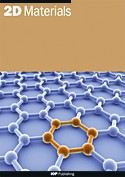
2D Materials, 2019; 7
Hirunpinyopas, Wisit & Prestat, Eric & Iamprasertkun, Pawin & Bissett, Mark & Dryfe, Robert
Laminar MoS2 membranes show outstanding potential for practical applications in energy conversion/storage, sensing, and as nanofluidic devices. The re-stacking of exfoliated MoS2 creates nanocapillaries between the layers of MoS2 nanosheets. These MoS2 membranes have been shown to possess a unique combination of ionic rejection properties, high water permeation rates, and long-term solvent stability, with no significant swelling when exposed to aqueous or organic solvents. Chemical modification of MoS2 membranes has been shown to improve their ionic rejection properties, however the mechanism behind this improvement is not well understood. In this work, we elucidate the ion-sieving mechanism by the study of potential-dependent ion transport through functionalized MoS2 membranes. The ionic permeability of the MoS2 membrane is transformed by chemical functionalization with a simple naphthalene sulfonate dye (sunset yellow) and with a resultant attenuation of permeability by at least an order of magnitude, compared to the pristine MoS2 membranes and permeability reported for graphene oxide and Ti3C2T x (MXene) membranes. The effects of pH, solute concentration, and ionic size/charge on the ionic selectivity of the functionalized MoS2 membranes are also reported. Understanding the mechanism of ionic sieving within functionalized MoS2 membranes will enable future applications in electro-dialysis and ion exchange for water treatment technologies.
